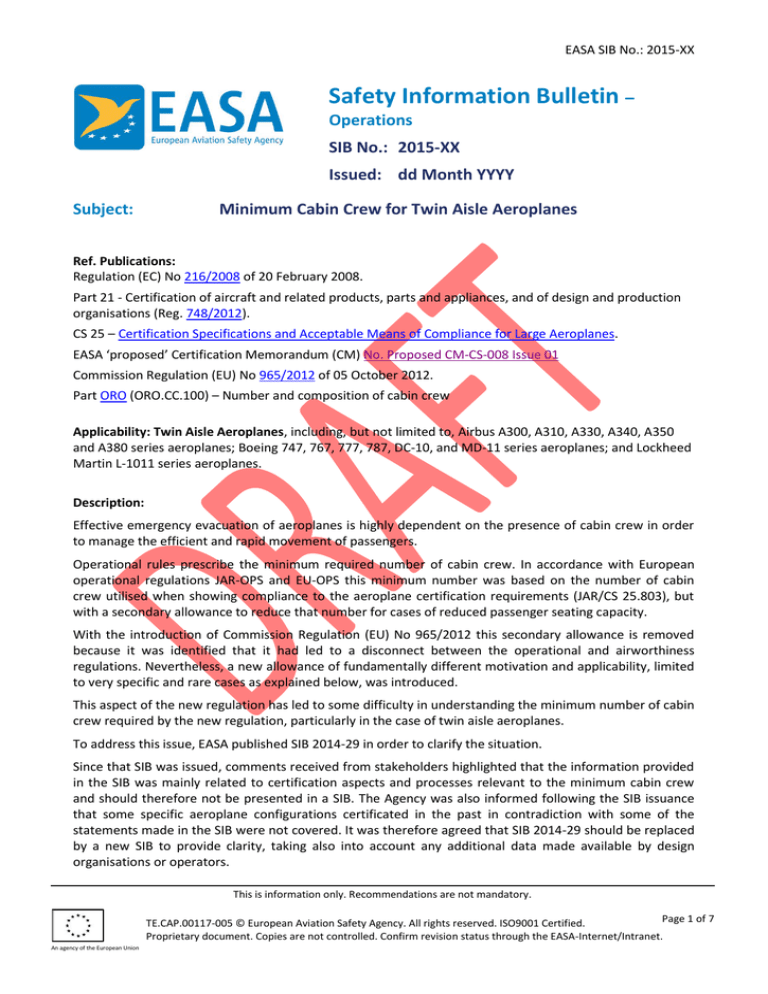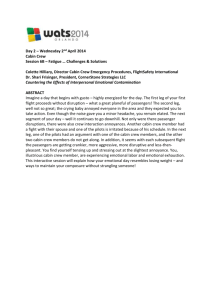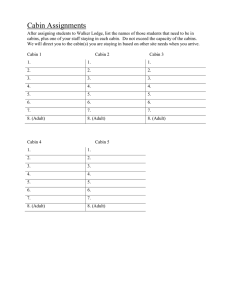
EASA SIB No.: 2015-XX
Safety Information Bulletin –
Operations
SIB No.: 2015-XX
Issued: dd Month YYYY
Subject:
Minimum Cabin Crew for Twin Aisle Aeroplanes
Ref. Publications:
Regulation (EC) No 216/2008 of 20 February 2008.
Part 21 - Certification of aircraft and related products, parts and appliances, and of design and production
organisations (Reg. 748/2012).
CS 25 – Certification Specifications and Acceptable Means of Compliance for Large Aeroplanes.
EASA ‘proposed’ Certification Memorandum (CM) No. Proposed CM-CS-008 Issue 01
Commission Regulation (EU) No 965/2012 of 05 October 2012.
Part ORO (ORO.CC.100) – Number and composition of cabin crew
Applicability: Twin Aisle Aeroplanes, including, but not limited to, Airbus A300, A310, A330, A340, A350
and A380 series aeroplanes; Boeing 747, 767, 777, 787, DC-10, and MD-11 series aeroplanes; and Lockheed
Martin L-1011 series aeroplanes.
Description:
Effective emergency evacuation of aeroplanes is highly dependent on the presence of cabin crew in order
to manage the efficient and rapid movement of passengers.
Operational rules prescribe the minimum required number of cabin crew. In accordance with European
operational regulations JAR-OPS and EU-OPS this minimum number was based on the number of cabin
crew utilised when showing compliance to the aeroplane certification requirements (JAR/CS 25.803), but
with a secondary allowance to reduce that number for cases of reduced passenger seating capacity.
With the introduction of Commission Regulation (EU) No 965/2012 this secondary allowance is removed
because it was identified that it had led to a disconnect between the operational and airworthiness
regulations. Nevertheless, a new allowance of fundamentally different motivation and applicability, limited
to very specific and rare cases as explained below, was introduced.
This aspect of the new regulation has led to some difficulty in understanding the minimum number of cabin
crew required by the new regulation, particularly in the case of twin aisle aeroplanes.
To address this issue, EASA published SIB 2014-29 in order to clarify the situation.
Since that SIB was issued, comments received from stakeholders highlighted that the information provided
in the SIB was mainly related to certification aspects and processes relevant to the minimum cabin crew
and should therefore not be presented in a SIB. The Agency was also informed following the SIB issuance
that some specific aeroplane configurations certificated in the past in contradiction with some of the
statements made in the SIB were not covered. It was therefore agreed that SIB 2014-29 should be replaced
by a new SIB to provide clarity, taking also into account any additional data made available by design
organisations or operators.
This is information only. Recommendations are not mandatory.
Page 1 of 7
TE.CAP.00117-005 © European Aviation Safety Agency. All rights reserved. ISO9001 Certified.
Proprietary document. Copies are not controlled. Confirm revision status through the EASA-Internet/Intranet.
An agency of the European Union
EASA SIB No.: 2015-XX
As a result, EASA ‘proposed’ CM No. Proposed CM-CS-008 Issue 01 has been developed and published on
EASA website and this SIB , which replaces SIB 2014-29, introduces new recommendations. The two
documents are complementary and should be read in conjunction.
Background information
Commission Regulation (EU) No 965/2012 for Air Operations was developed based on the Essential
Requirements specified in Regulation (EC) No 216/2008 Annex IV and on the transposition of EU-OPS
requirements.
It was identified that the reduction of the minimum required cabin crew in case of lower passenger seating
capacities, as allowed by EU OPS 1.990(b)(2), could lead to a number of cabin crew not compatible with the
applicable certification specifications. This disconnect had to be addressed, which was achieved with the
new ORO.CC.100 by clarifying that the cabin crew number established by certification (see Note 1 below)
was to be used as a reference, whilst a reduction of that number was limited to very few specific cases, as
described in EASA ‘proposed’ CM No. Proposed CM-CS-008 Issue 01 and also referred to in Note 3 of the
enclosed Appendix 2.
This SIB is therefore issued to ensure a correct understanding of ORO.CC.100 by providing information on
the existing certification provisions and processes relevant to the determination of the minimum cabin
crew.
This SIB does not introduce changes to the requirements specified in ORO.CC.100 and applicable since 28
October 2014. It aims at highlighting to stakeholders the various aspects that must be taken into
consideration, based on EASA ‘proposed’ CM No. Proposed CM-CS-008 Issue 01.
Note 1: The number of cabin crew utilised to show compliance to the aeroplane certification specifications
(JAR1/CS 25.803), JAR 25.803 being the reference for currently operated aircraft certificated before EASA.
Minimum Cabin Crew and Passenger Emergency Evacuation Management
EASA ‘proposed’ CM No. Proposed CM-CS-008 Issue 01 provides detailed information on the various
aspects that are assessed during the certification process of an aeroplane type as relevant to the minimum
cabin crew necessary to conduct an evacuation, and on other cabin and passenger aspects that may affect
the safety of the evacuation, and eventually the survivability rate (e.g. distance between exits and risks
associated to floor level exits not supervised by cabin crew).
It describes the differences between single aisle aeroplanes and twin-aisle aeroplanes and the various
levels of risk induced by these differences, and explains that the minimum number of cabin crew,
considered for twin-aisle aeroplanes as meeting the objective of the applicable certification specifications,
should be such as to ensure that at least one cabin crew member is stationed at each floor-level exit.
Operational Regulations
Regulation (EC) No 216/2008, Annex IV Air Operations, point 7a reads as follows:
The number and composition of the crew must be determined taking into account:
(i)
the certification limitations of the aircraft, including if applicable, the relevant emergency evacuation
demonstration;
(ii) the aircraft configuration; and
(iii) the type and duration of operations.
This is information only. Recommendations are not mandatory.
Page 2 of 7
TE.CAP.00117-005 © European Aviation Safety Agency. All rights reserved. ISO9001 Certified.
Proprietary document. Copies are not controlled. Confirm revision status through the EASA-Internet/Intranet.
An agency of the European Union
EASA SIB No.: 2015-XX
Commission Regulation (EU) No 965/2012 specifies more detailed requirements, as follows:
ORO.CC.100 Number and composition of cabin crew
(a) […]
(b) For the purpose of complying with (a), the minimum number of cabin crew shall be the greater of the
following:
(1) the number of cabin crew members established during the aircraft certification process in accordance
with the applicable certification specifications, for the aircraft cabin configuration used by the
operator; or
(2) if the number under (1) has not been established, the number of cabin crew established during the
aircraft certification process for the maximum certified passenger seating configuration reduced by 1
for every whole multiple of 50 passenger seats of the aircraft cabin configuration used by the operator
falling below the maximum certified seating capacity; or
(3) one cabin crew member for every 50, or fraction of 50, passenger seats installed on the same deck of
the aircraft to be operated.
(c) […].
Feedback received from stakeholders has shown that there is some misunderstanding concerning the
difference of scope between EU OPS 1.990(b)(2) and ORO.CC.100(b)(2). ORO.CC.100(b)(2) also allows a
reduction of the number of cabin crew in a way numerically identical to EU OPS 1.990(b)(2). However, this
is only provided for cases where “the number under (1) has not been established” (e.g. some aeroplanes
with a type certification basis from before 1967 (see Note 2 below).
This is further clarified by GM1 ORO.CC.100(b), as follows:
The number of cabin crew referred to in ORO.CC.100(b)(1) means either:
(1) the number […]; or
(2) a lower number of cabin crew […], and for which approval has been obtained for a cabin configuration
other than the MPSC, either by the TC holder or by another design organisation. The operator should
obtain a clear indication of that number which is specified in the related documentation. If a lower
number is not specified, the number established at the time of the initial type certificate applies.
Note 2: Application for type certificate (TC) made before 24 October 1967, which was the date of
introduction of section 25.803 in FAR-25.
Minimum Cabin Crew for Specific Aeroplane Types
As indicated in EASA ‘proposed’ CM No. Proposed CM-CS-008 Issue 01, the TC holder or Supplemental Type
Certificate (STC) holder, as applicable, should, when contacted, provide operators with the necessary
certification information relevant to their particular cabin configurations/passenger seating capacities and
the minimum number of cabin crew.
Therefore, operators, once provided with the relevant information concerning the number established
during the certification process, will be in position to determine the minimum number of cabin crew
required to operate their aeroplanes. In case of difficulty in finding such information, operators may refer
to the EASA Certification Directorate.
At this time, the safety concern described in this SIB does not warrant the issuance of a safety measure
under Regulation (EU) 965/2012, Annex II, ARO.GEN.135(c).
This is information only. Recommendations are not mandatory.
Page 3 of 7
TE.CAP.00117-005 © European Aviation Safety Agency. All rights reserved. ISO9001 Certified.
Proprietary document. Copies are not controlled. Confirm revision status through the EASA-Internet/Intranet.
An agency of the European Union
EASA SIB No.: 2015-XX
Recommendation(s):
Based on the information provided in this SIB concerning how to comply with ORO.CC.100,
Operators of twin aisle aeroplanes should:
o
request from the design organisation that holds the TC of their particular aeroplane(s), or the STC of
their particular aeroplane (cabin) configuration, the certification documentation and data relevant to
the minimum cabin crew; and
o
review, and update if necessary, the minimum required cabin crew number(s) currently specified in
their Operations Manual.
Operators of twin aisle aeroplanes certificated with only one cabin crew station at an emergency exit
pair (see Note 6 of the attached Appendix 2) should in addition:
o
conduct a risk assessment with regard to any floor level exit not supervised by a cabin crew member,
and
o
review, and update if necessary, the minimum number of cabin crew and/or the operating procedures
established for these aeroplanes to ensure that the objective of the certification and operational rules
can be met.
Competent authorities should ensure that the aspects described in this SIB and in EASA ‘proposed’ CM No.
Proposed CM-CS-008 Issue 01 are given appropriate consideration.
Contact(s):
For further information contact the EASA Safety Information Section, Certification Directorate.
E-mail: ADs@easa.europa.eu.
This is information only. Recommendations are not mandatory.
Page 4 of 7
TE.CAP.00117-005 © European Aviation Safety Agency. All rights reserved. ISO9001 Certified.
Proprietary document. Copies are not controlled. Confirm revision status through the EASA-Internet/Intranet.
An agency of the European Union
EASA SIB No.: 2015-XX
APPENDIX 1
Difference between EU-OPS 1.990 and ORO.CC.100
The following example illustrates how the minimum number of cabin crew may differ depending on
whether it is determined according to EU-OPS 1.990 or to ORO.CC.100.
AEROPLANE CONFIGURATION – FOUR PAIRS OF TYPE A EXITS
Certification Evacuation Demonstration – 440 passengers (maximum allowable in accordance with the
certification regulation CS 25 for this exit configuration) with 9 cabin crew (as required by the “one per 50”
element of the regulation), with one stationed at each of the emergency exits, and the ninth cabin crew
member also stationed adjacent to one of the emergency exits.
Taking an Actual Airline Configuration of 332 seats,
Allowable Minimum Cabin Crew – 440 passengers with 9 cabin crew is an acceptable starting point,
According to EU OPS 1.990(b)(2), the reduction in seating capacity from this point is 108 seats (440-332),
which is twice a “whole multiple of 50 seats”, and thus the minimum required number of cabin crew could
be 9 reduced by 2 which equals 7.
According to ORO.CC.100, noting that the provisions of ORO.CC.100(b)(2) do not apply upon initial review,
the minimum required number of cabin crew is 9 for any passenger seating capacity, unless otherwise
demonstrated in accordance with the certification specification (JAR/CS 25.803) that does allow for
analysis, as well as actual demonstration. A supplemental analysis might thus be performed within the
certification domain to show that for a passenger configuration of 400 seats, successful evacuation can also
be achieved with only 8 cabin crew.
If such an analysis were to be performed by an appropriately qualified organisation (e.g. an EASA approved
Design Organisation) and accepted by EASA, this lower number of cabin crew (i.e. 8) would then be
considered compliant with ORO.CC.10 (b)(1) for any passenger configuration of 400 seats or fewer.
This has actually been achieved for an existing aeroplane type meeting the description of the example
aeroplane used here.
However, another analysis to show, for instance, that the example aeroplane with cabin layouts with
seating capacities of 350 passengers or fewer could be successfully evacuated with only 7 cabin crew would
not be accepted by EASA as compliant with the certification specifications, this due to a reduction in the
level of safety during an emergency evacuation. Thus such an analysis could not be used to determine the
minimum required number of cabin crew according to ORO.CC.100.
This is information only. Recommendations are not mandatory.
Page 5 of 7
TE.CAP.00117-005 © European Aviation Safety Agency. All rights reserved. ISO9001 Certified.
Proprietary document. Copies are not controlled. Confirm revision status through the EASA-Internet/Intranet.
An agency of the European Union
EASA SIB No.: 2015-XX
APPENDIX 2
The table below is provided for convenience. It indicates the minimum cabin crew numbers established on
the basis of one cabin crew member for each floor-level exit as described in EASA ‘proposed’ CM No.
Proposed CM-CS-008 Issue 01. As explained in Notes 1 to 6, these numbers may need to be adapted
depending on particularities of the aeroplane’s configuration.
Basic Minimum Cabin Crew for Twin Aisle Aeroplanes
Aeroplane Type
Exit Arrangement
Minimum Cabin Crew
A300
A-A-A-A or A-A-I-A
8
A310
A-III-A
4
A310
A-I-A
6
A330
A340
A-A-A-A or A-A-I-A or
A-A-III-A-A
8
A350
A-A-A-A or C-A-A-A,
A-A-C-A or C-A-C-A
8
A380
A-A-A-A-A main deck
A-A-A upper deck
10 main deck
6 upper deck
747
A-A-A-A-A main deck
-A- or –I- upper deck
10 main deck
1 upper deck
767
A-III-A
4
767
A-III-III-A
4
767
A-A-III-A
6
767
A-A-I-A
8
777
A-A-A-A
8
777
A-A-A-A-A
10
787
A-A-A-A or C-A-A-A,
A-A-C-A or C-A-C-A
8
L-1011
A-A-A
6
L-1011
A-A-A-I or A-A-I-A
8
DC-10
B-A-A-A
8
MD-11
B-A-A-A
8
This is information only. Recommendations are not mandatory.
Page 6 of 7
TE.CAP.00117-005 © European Aviation Safety Agency. All rights reserved. ISO9001 Certified.
Proprietary document. Copies are not controlled. Confirm revision status through the EASA-Internet/Intranet.
An agency of the European Union
EASA SIB No.: 2015-XX
Notes
1.
Emergency exit configurations described in the table start with the most forward exit pair and moving
aft. For example “A-A-I-A” denotes an aeroplane with four exit pairs, the most forward pair being Type
A exits, the exit pair immediately aft of those also being Type A exits, the exit pair aft of those being
Type I exits, and the aft most exit pair being Type A exits.
2.
De-rating of emergency exits. Emergency exit configurations included above are those approved for
the aeroplanes in question at initial certification. Emergency exits are sometimes “de-rated” to a
smaller type in order to take advantage of regulatory differences that allow, for instance, the deletion
of one cabin crew member assist space (e.g. Type A de-rated to Type C). Such de-ratings do not affect
the minimum number of cabin crew members required.
3.
Other arrangements than those listed in the table, for instance those resulting from disabling one or
more exits, such as for a “VIP” aeroplane or when creating a ”Combi” aeroplane, or perhaps other nontraditional designs, may be acceptable for operation with fewer cabin crew than indicated above.
However, this must be confirmed by specific instructions associated with an EASA approved aeroplane
change.
4.
Type III exits. Some twin aisle aeroplanes are configured with Type III exits. In some cases cabin crew
seat(s) may be installed in their vicinity. Operators of such aeroplanes should contact the TC/STC
holder and/or the Agency in order to clarify whether these cabin crew seats have been required
following the identification of issues during evaluation of emergency evacuation capability. If so
confirmed, the calculated minimum cabin crew should be based on all those seats being occupied, in
addition to the number of cabin crew listed in the table .
5.
Specific emergency evacuation aspects. A minimum cabin crew number greater than that specified in
the table may be required when additional cabin crew are required to compensate for specific
emergency evacuation aspects identified during certification.
6.
Aeroplanes with less than one cabin crew station per exit pair. There are very few twin aisle
aeroplanes that were certificated in the past with only one cabin crew station installed at an
emergency exit pair. This may obviously result in these aeroplanes being operated with fewer than 2
cabin crew members at that emergency exit pair. These cases are addressed in EASA ‘proposed’ CM
No. Proposed CM-CS-008 Issue 01.
This is information only. Recommendations are not mandatory.
Page 7 of 7
TE.CAP.00117-005 © European Aviation Safety Agency. All rights reserved. ISO9001 Certified.
Proprietary document. Copies are not controlled. Confirm revision status through the EASA-Internet/Intranet.
An agency of the European Union


